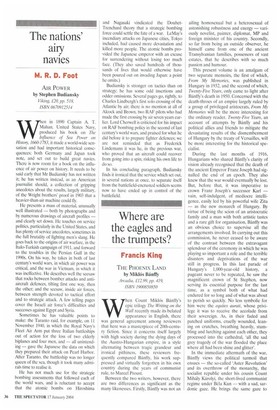'The nations' airy navies
M. R. D. Foot
AIR POWER by Stephen Budiansky Viking, £20, pp. 518, ISBN 0670912514 Influence in 1890 Captain A. T.
Mahan, United States Navy,
produced his book on The Influence of Sea Power on History, 1660-1783, it made a world-wide sensation and had important historical consequences; both Germany and Japan took note, and set out to build great navies. There is now room for a book on the influence of air power on history. It needs to be said early that Mr Budiansky has not written it; he has written instead, as an American journalist should, a collection of gripping anecdotes about the results, largely military, of the Wright brothers' proof in 1903 that a heavier-than-air machine could fly.
He presents a mass of material, unusually well illustrated — both by photographs and by numerous drawings of aircraft profiles — and clearly set down. He touches on service politics, particularly in the United States, and has plenty of service anecdotes, sometimes in the full brutality of fighting men's slang. He goes back to the origins of air warfare, in the Italo-Turkish campaign of 1911, and forward to the troubles in the Persian Gulf in the 1990s. On his way, he takes in both of last century's world wars, in which air power was critical, and the war in Vietnam, in which it was ineffective. He describes well the seesaw that rocks between bomber attacks and antiaircraft defences, tilting first one way, then the other; and the seesaw, inside air forces, between strength devoted to tactical effort and to strategic attack. A few telling pages cover the Israeli air force's difficulties and successes against Egypt and Syria.
Sometimes he has valuable points to make: the Taranto raid, for example, on 11 November 1940, in which the Royal Navy's Fleet Air Arm put three Italian battleships out of action for the loss of two elderly biplanes and four men, and — all unintending — gave the Japanese the data on which they prepared their attack on Pearl Harbor. After Taranto, the battleship was no longer queen of the sea, though it took many admirals time to realise it.
He has not much use for the strategic bombing assessments that followed each of the world wars, and is reluctant to accept that the atomic bombs on Hiroshima and Nagasaki vindicated the DouhetTrenchard theory that a strategic bombing force could settle the fate of a war. LeMay's incendiary attacks on Japanese cities, Tokyo included, had caused more devastation and killed more people. The atomic bombs provided the Japanese emperor with an excuse for surrendering without losing too much face. (They also saved hundreds of thousands of lives that would otherwise have been poured out on invading Japan: a point he omits.) Budiansky is stronger on tactics than on strategy; he has some odd insertions and odder omissions. Several pages go, rightly, to Charles Lindbergh's first solo crossing of the Atlantic by air; there is no mention at all of Alcock and Brown, two RAF pilots who had made the first crossing by air seven years earlier. Lord Cherwell is criticised for his impact on RAF bombing policy in the second of last century's world wars, and praised for what he did before it to prepare fighter defences; we are not reminded that as Frederick Lindemann it was he, in the previous war, who proved that an aircraft could recover from going into a spin, risking his own life to do so.
In his concluding paragraph, Budiansky finds it ironical that the service which set out, in several nations at once, to separate itself from the battlefield-encrusted soldiers seems now to have ended up in control of the battlefield.


































































 Previous page
Previous page